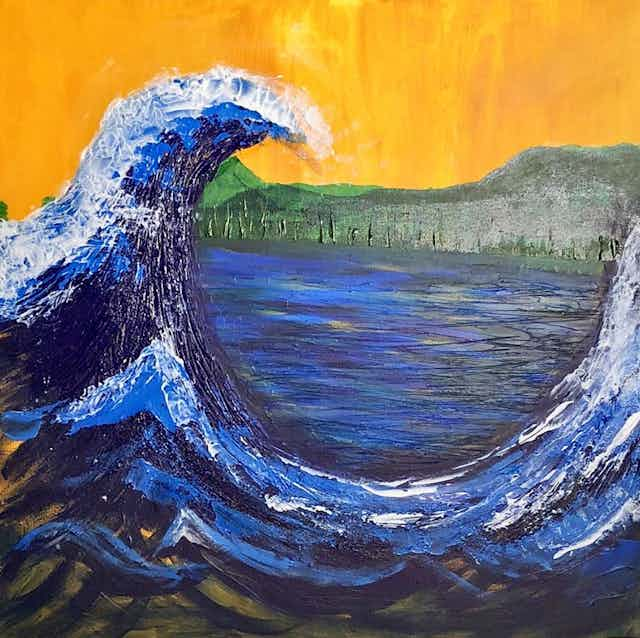Embarking on a Visual Trip Via the Lyrical Interpretations of Nature in Stylist Landscapes
Each brushstroke, each play of light and darkness, and each color option in their jobs talks quantities about the musicians' deep link to nature and their ability to translate its elegance onto the canvas. As we discover the lyrical interpretations of nature in Impressionist landscapes, we are welcomed to submerse ourselves in a globe where fact and feeling link, supplying a peek right into the musicians' profound appreciation for the all-natural world.
The Exciting Brushstrokes of Claude Monet
Claude Monet's mastery of brushstrokes transcends simple method, imbuing his landscapes with a spiritual high quality that enthralls and mesmerizes customers - trump art. His innovative use of color and light, combined with his distinctive brushwork, produces a sense of activity and life within his paints. Monet's prominent series of jobs depicting water lilies and his famous haystacks showcase his capacity to catch the short lived impacts of light and ambience

Enjoying Light and Shadow With Camille Pissarro
Symbolizing a similar reverence for the interaction of light and shadow, Camille Pissarro's artistic vision unravels as an unified expedition of the all-natural world's luminous subtleties. Pissarro, a vital number in the Impressionist motion, masterfully caught the dynamic connection between light and shadow in his landscapes. His proficient usage of shade and brushwork permitted him to communicate the subtle changes in light that define various times of day and periods.
Pissarro's paints frequently feature spotted sunlight filtering through fallen leaves, casting detailed patterns of light and shadow on the earth listed below. In works such as "Hoar Frost, the Effect of Snow, Pontoise," Pissarro skillfully portrays the crisp illumination of winter months sunlight juxtaposed with the cool shadows that specify the snowy landscape. By embracing both light and darkness in his structures, Pissarro welcomes customers to submerse themselves in the natural elegance and transient impacts of light in the world around them.

With Pissarro's works, we are reminded of the transformative power of light and darkness, welcoming us to pause and value the short lived minutes of charm present in the daily landscapes that surround us.
A Symphony of Color Styles by Edgar Degas
Edgar Degas coordinates a vibrant symphony of colors in his skillful art work, instilling his structures with a vibrant interaction of tones that captivate the customer's look. Recognized primarily for his ballet dancers and intimate scenes of Parisian life, Degas skillfully controlled colors to convey mood and motion in his paintings. trump art. His use of vibrant, different shades and refined tonal variations created a sense of depth and vibrancy within his jobs
Degas' color combination frequently included rich blues, deep greens, and image source cozy oranges, which he used with content certain brushstrokes to capture the essence of his subjects. Whether depicting a ballerina mid-performance or a team of friends chatting at a cafe, Degas' colors not just depicted the scene yet additionally stimulated a sense of feeling and power.
In Addition, Degas' testing with light and shadow added an added layer of intricacy to his color make-ups, enhancing the total environment of his paintings (trump art). Through his skillful control of shade, Degas produced a visual symphony that continues to reverberate with audiences today
Exploring Nature's Serenity With Berthe Morisot
Berthe Morisot's creative vision offers a calm departure from the vibrant color harmonies of Edgar Degas, as she captures the harmony of nature in her expressive landscapes. Understood for her delicate brushwork and intimate representations of everyday life, Morisot's landscapes emanate a feeling of tranquility and harmony.
Morisot's paints typically include soft, soft tones that convey a feeling of peace and calmness. Her jobs, such as "The Cradle" and "Summertime's Day," showcase her capacity to record the refined beauty of nature in a manner that is both contemplative and relaxing to the audience.
Unlike a few of her Stylist equivalents who concentrated on dynamic compositions and strong colors, Morisot chose to create gentle, reflective scenes that invite the visitor to mirror and stop. Through her masterful use of light and shadow, Morisot creates a sense of serenity that reverberates with the viewer on a deep psychological level.
The Psychological Landscapes of Vincent Van Gogh
Vincent Van Gogh's landscapes strongly convey a depth of feeling via their dynamic brushwork and expressive use shade. The Dutch post-impressionist artist is renowned for his ability to capture extreme and raw emotions in his paintings, transcending typical depictions of nature. Van Gogh's troubled individual life, marked by mental health battles, considerably influenced his art, instilling his landscapes with a feeling of anxiousness, melancholy, or vitality.
In jobs such as "Starry Evening" and "Wheatfield with Crows," Van Gogh's swirling brushstrokes and dynamic color choices evoke an extensive emotional feedback from visitors. The unstable skies and upset landscapes in his paintings mirror his inner turmoil and psychological disturbance, inviting audiences to explore the complexities of his psyche.
Van Gogh's one-of-a-kind visual language, identified by overstated perspectives and bold usage of shade, develops landscapes that reverberate with viewers on a deeply emotional degree. With his art, Van Gogh invites us to see nature not simply as an exterior fact however as a mirror of our innermost feelings and emotions.
Verdict
To conclude, the impressionist landscapes of musicians such as Claude Monet, Camille Pissarro, Edgar Degas, Berthe Morisot, and Vincent Van Gogh supply a fascinating and special visual interpretation of nature. Through their use of brushstrokes, color, light, and feeling, these artists have actually created a symphony of pictures that stimulate a sense see post of serenity and beauty in the environment. Their jobs remain to influence and captivate customers with their lyrical interpretations of the landscapes around us.
Each brushstroke, each play of light and shadow, and each color selection in their jobs speaks quantities concerning the musicians' deep connection to nature and their capacity to translate its elegance onto the canvas. His cutting-edge usage of color and light, integrated with his distinct brushwork, creates a sense of motion and life within his paints. His adept use of color and brushwork allowed him to communicate the refined changes in light that define various times of day and periods.
